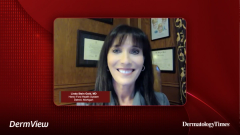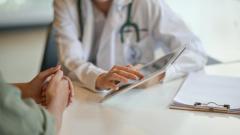
Treating Atopic Dermatitis with Ruxolitinib
Dr Matthew Zirwas describes his experience using JAK inhibitor ruxolitinib in his clinical practice.
Episodes in this series

Linda Stein Gold, MD: I want to switch gears. I know you were involved in the clinical trials, you had a lot of patients, and you’re very busy. We’re both medical dermatologists. We don’t just run clinical trials; we see patients in practice. Talk to me first about how you would fit ruxolitinib [Opzelura] into your treatment armamentarium for these patients with atopic dermatitis? Where would you put it? How would you use it?
Matthew Zirwas, MD: It’s a really interesting question. In the last couple of years, we’ve gotten data that clearly showed us that the chronic use of topical steroids is associated with the development of osteoporosis and the development of type 2 diabetes. From large population-based data sets, there are very good data sets, particularly from Denmark, that have shown us that.
We know that there’s a risk with long-term use of topical steroids. Where I end up using these is in when I give a topical steroid, they get better, and they don’t need to keep using the topical steroid on a chronic basis. The person who’s 2 weeks on, 1 week off—and it’s just a constant 2 weeks on, 1 week on, 2 weeks on, 1 week off. Or I’ll do Monday through Friday and take the weekends off. We are constantly using the topical steroid. It’s not as if we use this for a week or 2, then you’ll be better—you won’t need to use anything for a few months, and then you’ll need to use it again. In that situation, topical steroids don’t make the most sense to me.
This is a drug that my full expectation and the indication on the drugs is for chronic non-continuous use. I tell patients to use this twice a day. In most patients, it clears it up completely. Once it clears up completely, stop using it. When you notice it starts to come back again, start to use it again. You’re going to use it on and off. I don’t think of it as a replacement for topical steroids, but if somebody isn’t getting to the point where they’re going into a remission—where they can be off the topical steroids for a relatively prolonged period of time—this drug makes a lot more sense.
The other places where it makes a lot of sense is in my patients with facial atopic dermatitis. In these patients, you’re seeing some of the steroid adverse effects and are in acute order popliteal fossa—things like that. For me, it’s a drug used as a replacement for chronic use of topical steroids, which I know for certain have long-term effects and are used as a replacement for topical steroids in places where it’s inadvisable to use a topical steroid: the face, the groin, and other sensitive skin areas.
Linda Stein Gold, MD: In a similar way, we have so many patients who have atopic dermatitis disease in multiple body surface areas [BSAs]. Many times, the patient leaves the office with 3 or 4 prescriptions. Both of us have gotten along in our practices. We’ve understood that if you can simplify the regimen down and give them 1 or 2 things to do as opposed to 4 or 5 things, the patient will have a better idea of what to do when they get home and can feel like they have better control of their disease.
When somebody has facial disease, as well as disease on the body or any sensitive areas, they should use ruxolitinib. This helps simplify it. Steroids will always have a role in atopic dermatitis. I don’t think any of these replace one another. We need a lot of good options to get these diseases under control. The other thing is, when we see patients with skin of color, when you put a steroid on the skin, you certainly can bleach that out and cause dyspigmentation. We didn’t see that with the topical ruxolitinib. It’s a different mechanism of action. It’s a JAK inhibitor, and as you mentioned earlier, Matt, this is something that helps to normalize and calm down that type 2 inflammation and the pro-inflammatory cytokines that signal through that JAK-STAT pathway. But as you mentioned, no 1 drug is going to replace anything else. It’s another important tool.
When you’ve decided to use it, and I know you’ve had some practice with this, how do you talk to a family about what’s going to happen when they get the medicine, and the pharmacist says to them, “This has a box warning.” You’ve got to preempt it. We have to discuss it in the office first. How do you have that conversation?
Matthew Zirwas, MD: This is starting to be a routine. I could be thinking about where I’m going for dinner while I’m saying this. Whenever I prescribe it, the talk usually goes like this, “We’re going to prescribe you this new medication. It’s not a steroid, and you don’t have to worry about skin thinning or anything like that, and you don’t have to take a big break from it. You’re going to use it until your skin gets cleared up. Then stop using it. When you start to break out again, start to use it again.
“It’s going to come with a box warning from the pharmacy that says it may weaken your immune system, put you at risk for infections, and put you at risk for cancer and that it might cause blood clots. Whenever you get that, I don’t want you to be scared. As long as you don’t eat the topical cream, we probably don’t need to be too worried about those things. If you start eating the cream, all bets are off. As long as you’re not eating it, we know that only a very small amount, about 5% of the cream, that you put on your body gets into your blood. That’s such a small amount that we don’t think it has any of those effects.
“The reason you’re getting that piece of paper that that describes adverse effects is because this medication, and others like it, if you take them by mouth and a high level, gets into your blood. It definitely does weaken your immune system. It may or may not affect how your blood clots. And we know that whenever you’re putting it on as a cream, the amount that’s getting into your blood is so low that we don’t think it has any of those effects. I can’t promise you. I can’t say there’s no way it could have any of those effects, but the amount is so low that I don’t think it does.” Then they say, “So it’s not a steroid?” “No, it’s not a steroid.”
Linda Stein Gold, MD: I agree. People really want to try to get away from steroids. Physicians want to have another option because we don’t want to use steroids for long periods of time. We worry about thinning of the skin, about dyspigmentation, and certainly about stria, especially in sensitive areas. We want to have other options.
I have a very similar conversation with my patients. I explain that because of this class of drugs—and even this drug itself—is available orally, we have the same label for the oral as well as the topical. We have seen these adverse effects when given orally. It does have an effect on the immune system. I give them that warning: as long as you use it on the local areas—and nobody knows what’s up to 20% BSA is—and you don’t use it all over the body in large amounts, we should be absolutely fine. I tell them, “If you’ve developed any changes in your health status, infections, or anything that you’re concerned about, if you’re worried, stop the drug and give me a call.” I always do that.
Transcript edited for clarity.
Newsletter
Like what you’re reading? Subscribe to Dermatology Times for weekly updates on therapies, innovations, and real-world practice tips.





















